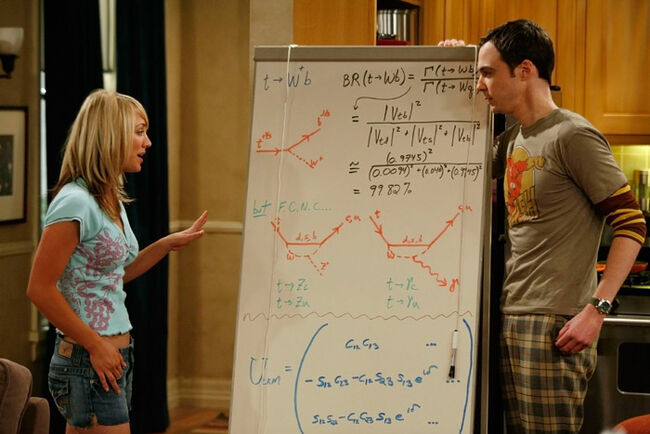HAPPY BANGSGIVING!
Sheldon's whiteboard: This one describes the decay of the top quark. As illustrated on the top right, in the standard model of electroweak interactions, the top quark decays essentially 100% of the time to Wb (i.e., the top quark decays to form a W+ boson and a bottom quark, t → W+b). To the contrary, in the standard model (SM), top quark flavor changing neutral current (FCNC) decays (t → Zq and t → γq) into the up or charm (q = u,c) are highly suppressed and featured below near the midpoint of the board; one of the properties of the top quark in the SM is it's extremely small FCNC interactions due to the Glashow-Iliopoulos-Maiani (GIM) mechanism. They do not occur at tree level and are only allowed at the level of quantum loop corrections, but at very small branching fractions on the order of 10-9 or smaller. (branching ratio/fraction: When a particle decays, it often can decay in several ways. The likelihood of it decaying to a particular mode is known as its branching ratio for that decay mode.) This will make any FCNC top quark process a robust evidence for new physics beyond the SM. The modes of quark flavor transformation necessary to accomplish these decay processes by the weak interaction are shown in Feynman diagrams.
Looking to the lower half of the board, the Cabibbo-Kobayashi-Maskawa (CKM) quark-mixing matrix VCKM,
- ,
describing the weak couplings of the charged gauge boson to quarks, can be found. It can be parameterized by three mixing angles (θ12, θ23, θ13) and the CP-violating KM phase (δ), where sij = sinθij and cij = cosθij (i < j = 1,2,3) are introduced and δ is the complex phase responsible for all CP-violating phenomena in flavor-changing processes in the SM. The last line of the whiteboard (not visible in the above image) reveals that in the standard model of electroweak interactions CP violation is due to a nonzero complex phase in the CKM matrix (δ ≠ 0 ⇒ CP).
Moreover, the measurement of BR(t → W+b) above can be interpreted as a measurement of the CKM matrix element Vtb. However, it is not necessarily the case that BR(t → W+b) = 1 implies |Vtb| = 1. This inference follows only in the absence of a fourth generation, where |Vtb| is constrained by unitarity (a property of the CKM matrix) and the known values of the other CKM matrix elements. A more general relationship, which is true for three or more generations provided that there is no fourth generation b' quark lighter than the top, is and reproduced precisely atop. (Observe that the branching ratio is defined as the partial decay width divided by the total width.)

Sheldon: Yeah, well, it’s just some quantum mechanics with a little string theory doodling around the edges. That part there's just a joke. It's a spoof of the Born-Oppenheimer approximation. Sheldon's dialogue is incompatible with the work presented on the whiteboard. The "doodling around the edges" are Feynman diagrams depicting the decay modes of the top quark in electroweak theory and physics beyond the Standard Model. When Sheldon references a purported spoof of the Born-Oppenheimer approximation (indispensable in quantum chemistry), he points at the CKM quark-mixing matrix and the associated criterion for CP violation beneath it.




